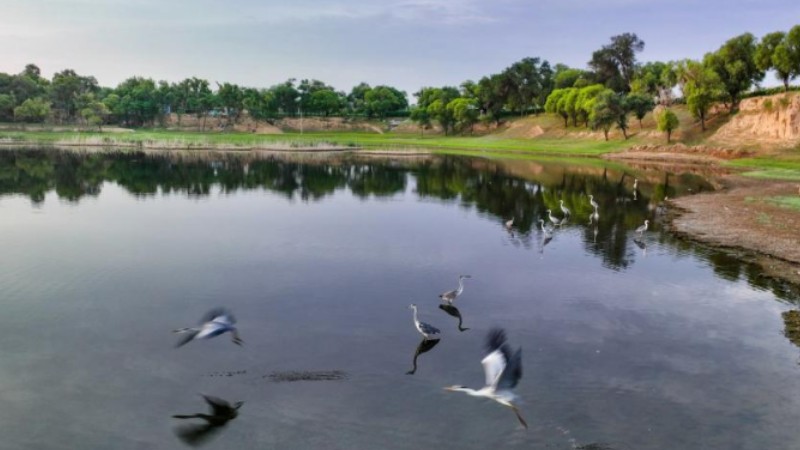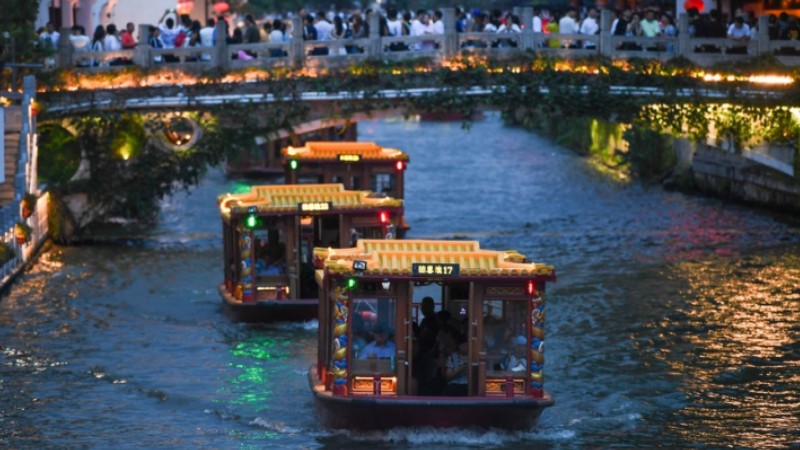AI opens new space for artistic creation

A woman admires paintings displayed at an Artificial Intelligence Generated Content (AIGC) art exhibition during the World Artificial Intelligence Conference (WAIC) 2023 in Shanghai. (Xinhua/Xin Mengchen)
Artworks can now be generated instantly without the need for traditional tools such as brushes or paint. By simply inputting a text description and selecting desired settings like image perspective, style, and rendering method, then clicking a button, one or multiple pieces of artworks can be produced.
The rapid advancement of Artificial Intelligence Generated Content (AIGC) is bringing artificial intelligence (AI)-generated paintings into the public eye. This emerging technology is opening up new creative possibilities for artists and painting enthusiasts to explore.
As an early pioneer of AI, artist Liu Jiayu created her first AI-generated work in 2018. She traveled to Vallee de Joux in Switzerland to find inspiration, photographing the sky 6,400 times. She then used these photos to train a machine learning model to generate a series of unique sky images. In 2022, Liu displayed another of her AI artworks at the China Pavilion of the 59th Venice Biennale.
Today, many artists and art professionals are utilizing AIGC in their creative practices. Especially for digital artists, AI has become an integral tool for artistic creation.
In 2022, AI painting technology advanced significantly, accelerating into a phase of rapid development.
According to Mu Ge, business head for Chinese tech giant Baidu's AI art generation platform Wenxin Yige, major breakthroughs in AI painting technology were achieved last year in two key areas: the integration of diffusion models into AI painting greatly enhanced the quality of creations, and the incorporation of knowledge enhancement enabled AI models to better understand and execute human prompts, resulting in more controllable and nuanced artworks.
"AI technology is advancing very quickly," said Jiang Feiran, a Ph.D. from the China Academy of Art.
"At the start of 2022, many were laughing at AI art for looking too abstract. But, remarkably, within months, AI systems progressed to generating artworks that closely resemble human-made paintings," said Jiang.
AI painting tools have a broad user base from professionals to hobbyists.
"For professionals, AI painting can spark creativity, generate ideas, aid artistic production, and increase efficiency," stated Mu. "For everyday users, it lets them channel their imagination and uniqueness while discovering the joy of making art."
AI painting can have a far-reaching and transformative impact on professionals.
"AI painting will profoundly transform and restructure the art world and creative ecosystems. It also stands to fundamentally change how we as humans produce and conceptualize art," said Jiang.
Jiang explained that while differences between AI and human-made art are currently still noticeable, the rapid maturation of AI technology suggests it may only be a matter of time before AI matches the nuance and ability of human painting techniques.
"I haven't tried AI painting tools yet, but I'm very intrigued," said veteran illustrator A Geng, known for her animation film posters, with over 20 years of industry experience.
However, A Geng believes AI will impact animation, comics, and game art sooner, with some foundational design work possibly replaced.
As AI technology continues advancing rapidly, its applications are also expanding.
"Moving forward, AI paintings will become increasingly sophisticated and precise, with technical barriers lowered to smartphone-like accessibility," observed Jiang. She believes these improvements will accelerate changes in artistic processes, with human-AI collaboration potentially becoming a trend.
The art industry broadly acknowledges that AI painting will not wholly replace human creativity and imagination.
"Strictly speaking, AI does not actually paint but performs calculations," Jiang explains. AIGC is based on probabilistic algorithm of massive datasets, however it lacks original intent. Instead, humans provide direction based on artistic vision, interpreting and selecting the output of AI," Jiang explained.
Photos
Related Stories
- Beijing to further regulate online medical services, prohibit AI generated prescriptions
- China-Oman high-tech cooperation contributes to Oman's digital transformation: expert
- Chinese firm iFLYTEK launches new version of AI language model
- China to explore frontier science, tech, using AI
- Over one tenth of German companies using AI: survey
Copyright © 2023 People's Daily Online. All Rights Reserved.









